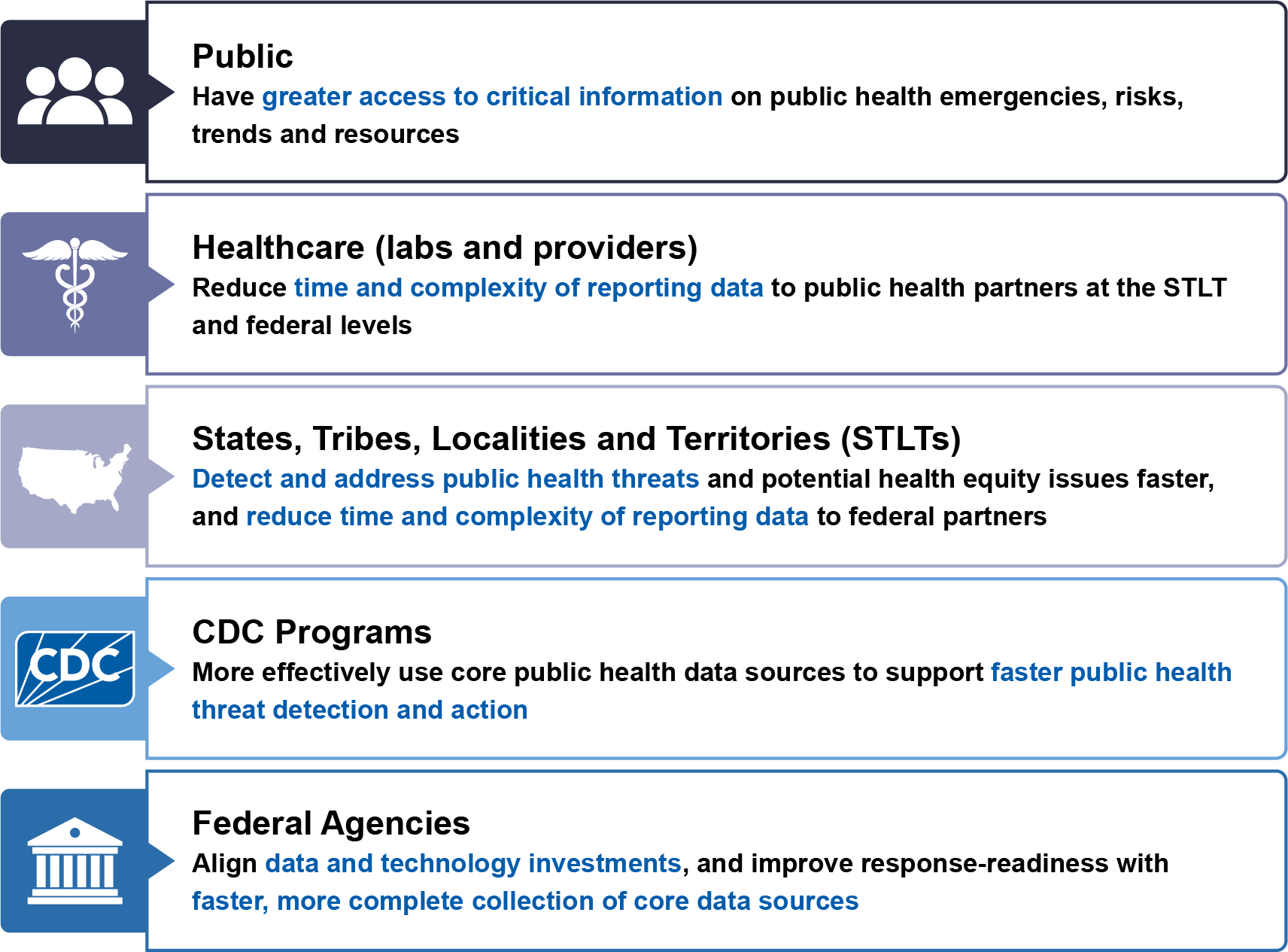Key points

How the PHDS Advances the Nation’s Public Health Ecosystem

What is the public health ecosystem?
The PHDS builds an integrated ecosystem producing and using public health data to improve our communities and keep people safe. It outlines a vision of data exchange that improves speed, quality and completeness.
It builds on lessons learned from recent public health threats such as COVID-19 and mpox to make the ecosystem more response-ready. And it aligns data modernization efforts across the ecosystem with concrete and measurable milestones.
The PHDS Empowers Partners with Data and Tools

Accessible Version of Image
Public: Have greater access to critical information on public health emergencies, risks, trends and resources.
Healthcare (labs and providers): Reduce time and complexity of reporting data to public health partners (at the STLT- and federal-levels).
STLTs: Detect and address public health threats and potential health equity issues faster, and reduce time and complexity of reporting data to federal partners.
CDC Programs: More effectively use core public health data sources to support faster public health threat detection and action.
Federal Agencies: Align data and technology investments, and improve response-readiness with faster, more complex collection of core data sources.
The Public Health Data Goals
The PHDS has been developed to create accountability for delivering progress against four public health data goals:
- Goal 1: Strengthen the core of public health data.
- Ensure core data sources are more complete, timely and rapidly exchanged.
- Ensure core data are available to support the ability to respond to public health threats.
- Ensure core data sources are more complete, timely and rapidly exchanged.
- Goal 2: Accelerate access to analytic and automated solutions to support public health investigations and advance health equity.
- Make tools available to better use public health data to address health disparities.
- Make tools available to better use public health data to address health disparities.
- Goal 3: Visualize and share insights to inform public health action.
- Offer situational awareness for the public and decision-makers.
- Offer situational awareness for the public and decision-makers.
- Goal 4: Advance more open and interoperable public health data.
- Enable access and use of data when needed.
- Enable access and use of data when needed.
Core Data Sources
Core data sources are data that, together, provide a picture of what is happening in our communities. They are essential to:
- Identify diseases and conditions.
- Detect emerging public health threats.
- Understand disease burden and severity.
- Take public health action.
These data can be used to understand any disease or condition, both in emergencies and every day.
The PHDS decreases the burden for STLT public health departments to securely report these critical data. It also improves dissemination to ensure the right data are available at the right time.
These are the core data sources currently being tracked. The list of core data sources will evolve as the public health ecosystem evolves.
- Case data:
- Offer comprehensive disease and condition information.
- Are used to understand disease burden.
- Help identify outbreaks and who is at risk.
- Have personally identifiable information removed.
- Offer comprehensive disease and condition information.
- Laboratory data:
- Include test results and test type.
- Are used to track disease trends.
- Help identify outbreaks or exposures.
- Helps providers diagnose and treat health conditions.
- Include test results and test type.
- Emergency department data:
- Include clinical diagnoses, signs and symptoms.
- Provide insight into near real-time trends.
- Can identify emerging and developing public health threats.
- Include clinical diagnoses, signs and symptoms.
- Vital statistics data:
- Include birth and death data.
- Are essential to understand disease severity and mortality.
- Can be used to understand trauma and toxicity.
- Can signal a larger public health emergency.
- Include birth and death data.
- Immunization data:
- Capture routine and response-related vaccine doses given.
- Are used to calculate vaccination coverage and trends.
- Capture routine and response-related vaccine doses given.
- Healthcare capacity and utilization data:
- Include staff, beds and equipment.
- Document availability of healthcare resources.
- Aid understanding health system stresses.
- Inform resource allocation.
- Include staff, beds and equipment.
- Wastewater surveillance data:
- Capture the presence of virus in wastewater samples.
- Serve as an early warning of virus spread.
- Capture the presence of virus in wastewater samples.
Did you know?
Data Modernization: Accelerating Data into Action
The PHDS builds on CDC's data modernization initiative (DMI) begun in 2019 to solve a number of problems.
A long-standing problem is siloed information with disconnected and/or proprietary systems that are keeping the nation from seeing a complete picture. This is often driven by disease-specific budget lines.
Many of today's public health workforce do not have the skills to use today's technologies more effectively.
The heavy burden for providers in health care and at health departments, required to send data to many places in many ways.
Older technologies at many health departments that are not flexible, do not use cloud and are not scalable.
A patchwork of policies with the variable landscape of data collection and reporting across the nation complicating rapid response to emerging threats. Healthcare data ecosystem that does not include public health, so public health was left behind as federal incentives and regulations helped healthcare systems be able to easily share data automatically in electronic health records.
DMI enables the PHDS by:
- Provides the vehicle for broad transformation.
- Includes major improvements such as need for state-of-the-art workforce, expanded partnerships, culture change and unified governance.
The PHDS accelerates DMI by:
- Lays out important steps that drive DMI priorities forward faster.
- Highlights what is most meaningful and achievable over the next two years.
- Identifies actionable goals that will yield the most impact.
Data modernization is not a "one and done." It is an ongoing, comprehensive and long-term effort involving CDC and STLT public health departments, other federal agencies and healthcare partners.
